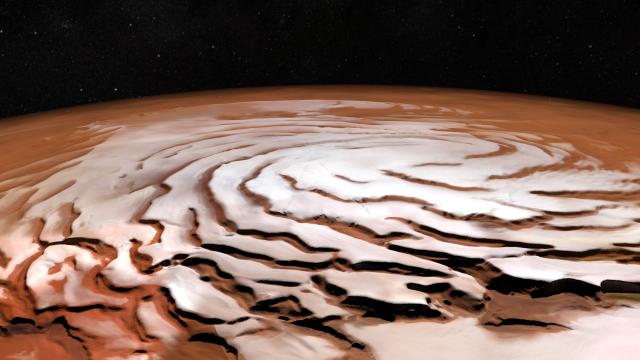Enigmatic features tucked inside two Martian impact craters could be the remnants of colossal ice avalanches, the largest of which travelled over 14 kilometres.
Two impact craters in the far northern latitudes of Mars have strange linear features on their inner slopes. New research published in Planetary and Space Science suggests these moraine-like ridges are what’s left of monumental ice avalanches that occurred around a million years ago.
Experts say it’s an interesting theory, but more work will be needed to bolster the claim.
Scientists had previously argued that these linear landforms look like moraines because that’s precisely what they are. Moraines are hilly, linear structures formed by slow-moving glaciers, which shove dirt and rocks at the head of their advance. In the Martian polar regions, these glaciers are made from carbon dioxide (rather than the water-ice that makes up Earth’s glaciers), but their geological effects are the same.
The new paper, co-authored by Sergey Krasilnikov from the Russian Academy of Sciences, proposes an alternative explanation: fast-running glacier surges. Essentially, the new paper argues that large towers of water ice, called massifs, located along the top slope of the craters collapsed, resulting in epic avalanches. The moraine-like ridges were formed by accumulating debris shoved to the bottom of the craters by collapsing massifs.
Krasilnikov and his colleagues simulated these hypothesised surges using data collected by NASA and by performing independent calculations. Together, these methods supported a scenario in which the “excessive accumulation of water ice on slopes” reached “a critical unstable condition,” resulting in the ice avalanches and the formation of the moraine-like ridges below.
Massifs form through the steady accumulation of frost. Eventually, the weight and pressure got so intense that the massifs collapsed, unleashing their contents to the bottom of the crater, according to this interpretation. These collapses would’ve been a sight to behold. The larger of the two collapses involved an estimated 2.42 square kilometres of ice, while the smaller involved 1.1 square kilometres. The larger massif was an estimated 150 metres tall, and the shorter one 100 metres tall.
The falling ice and debris would have travelled at an estimated 80 metres per second. And because gravity is lower on Mars, the debris spread across a wide territory, reaching some 15 kilometres from the starting point in the larger collapse, and 12 kilometres in the smaller one. During the larger massif collapse, the avalanche encompassed a total area extending 104 square kilometres.
“It’s a nice alternative explanation,” Mike Sori, a planetary scientist from the University of Arizona who wasn’t involved in the new research, told EOS, a publication of the American Geophysical Union. Martian avalanches have been documented before, he said, but these ridges look an awful lot like moraines crafted by carbon dioxide glaciers, he said. Sori said more evidence will be required to make a stronger case.
Future research will also have to figure out why only two examples of ice avalanches have been found on Mars, as EOS points out. Indeed, more examples of these strange ridges would add credence to the claim that ice avalanches do actually occur on the Red Planet.
